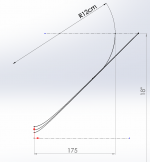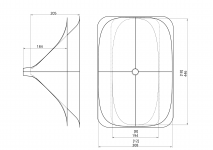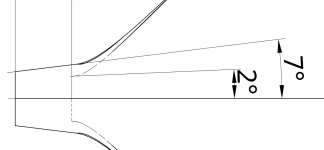I'm a little confused about the different dimensions of the various SEOS waveguides, the SEOS-18 with the 1.5 or 1.4 inch throats in particular.
Why are the dimensions of these two different than all of the others? They’re deeper than the 1” version (which is counter intuitive to me) and taller as well. But if we go up in size with the 22 and 24 the dimensions are similar to the 12 and 15 again and with the 22 in particular the dimensions are the same for all throat sizes, just a little deeper for smaller throats (which is what I would expect). So why are the large throat SEOS-18 different from all the other ones?
I'm basing this on the data provided by the polish manufacturer.
Why are the dimensions of these two different than all of the others? They’re deeper than the 1” version (which is counter intuitive to me) and taller as well. But if we go up in size with the 22 and 24 the dimensions are similar to the 12 and 15 again and with the 22 in particular the dimensions are the same for all throat sizes, just a little deeper for smaller throats (which is what I would expect). So why are the large throat SEOS-18 different from all the other ones?
I'm basing this on the data provided by the polish manufacturer.
Depth depends on:
- coverage: seos is 90x60
- roundover at mouth
SEOS-18 on rendering looks like having smaller roundover thus deeper. Also it uses conical extension from 1,5" to 1,4".
History: I was one who drawn SEOS back in 2010 at AVS forum. Name came from AVS users.
- coverage: seos is 90x60
- roundover at mouth
SEOS-18 on rendering looks like having smaller roundover thus deeper. Also it uses conical extension from 1,5" to 1,4".
History: I was one who drawn SEOS back in 2010 at AVS forum. Name came from AVS users.
Thanks for chiming in jzagaja! I'm aware of the history of the development, but I have not read through the entire thread on AVS. I'm sure there's a ton of information in there, but it's just too much to go through post by post. And I'm not aware of any systematic summary, so any hint towards something like that would be greatly appreciated.
That being said, I still don't get it. Why would the 1.4 & 1.5-inch SEOS-18 have a smaller roundover than it's 1-inch throat sibling? Also for 1.4 & 1.5 the mouth measures 476 x 328 whereas the 1-inch version is 465 x 213.
The SEOS-22 has the exact same dimensions for all throat sizes, the only variable being increasing depth for the smaller throats, which is frankly what I would expect to be the case.
So why does the 18 have a completely different geometry for different throat sizes when the 22 doesn't?
That being said, I still don't get it. Why would the 1.4 & 1.5-inch SEOS-18 have a smaller roundover than it's 1-inch throat sibling? Also for 1.4 & 1.5 the mouth measures 476 x 328 whereas the 1-inch version is 465 x 213.
The SEOS-22 has the exact same dimensions for all throat sizes, the only variable being increasing depth for the smaller throats, which is frankly what I would expect to be the case.
So why does the 18 have a completely different geometry for different throat sizes when the 22 doesn't?
Smaller roundover == better pattern control
Larger roundover (>12cm) == smoother response
SEOS 22 - one waveguide but few throats via conical extension == additional resonance at 1-2kHz
Best if you create waveguide designed for your driver.
Larger roundover (>12cm) == smoother response
SEOS 22 - one waveguide but few throats via conical extension == additional resonance at 1-2kHz
Best if you create waveguide designed for your driver.
I'm afraid designing (and actually making) a custom waveguide is out of the question. I simply don't have the means. But it did cross my mind that it would be nice to have a SEOS variant for throatless drivers.
That aside I still don't get it. Sorry ;-) But according to that logic the 1-inch version of the SEOS-18 should be higher at the mouth than the 1.4-inch version, not the other way around. Adding roundovers to a given 'rectangle' makes it more square in its outer dimensions, but for some reason the 1-inch version is a lot less square while being the one with the bigger roundovers? What am I missing?
That aside I still don't get it. Sorry ;-) But according to that logic the 1-inch version of the SEOS-18 should be higher at the mouth than the 1.4-inch version, not the other way around. Adding roundovers to a given 'rectangle' makes it more square in its outer dimensions, but for some reason the 1-inch version is a lot less square while being the one with the bigger roundovers? What am I missing?
Thank you, that's very kind of you to provide me with these contours. But it actually reinforces my concerns /questions about the 1.4 / 1.5 inch version of the SEOS-18 as the different contours should clearly be very similar according to your drawing.
The reason I'm asking all these questions is that to me on paper for a directivity matched 900ish Hz crossover the SEOS-18 looks ideal. And 900Hz is pretty low for a 1-inch driver, so a 1,4-inch driver with good extension would be ideal, the Faital HF1440 comes to mind for example. But there's a million threads on drivers and crossover points etc.
So I'm quite specifically looking at the 1,4-inch version of the SEOS-18 and something just seems wrong and none of your replies have really helped me understood why this particular member of the SEOS family should be such an outlier dimensionally. If it truly is about different roundovers, the first question would be "why change them for one model and one model only" plus as I've tried to argue above the dimensions should change towards a less square shape with smaller roundovers, not a more square one.
Why is the 1,4-inch SEOS-18 shaped completely different than all of its siblings? That's really all I'd like to know. 🙂
The reason I'm asking all these questions is that to me on paper for a directivity matched 900ish Hz crossover the SEOS-18 looks ideal. And 900Hz is pretty low for a 1-inch driver, so a 1,4-inch driver with good extension would be ideal, the Faital HF1440 comes to mind for example. But there's a million threads on drivers and crossover points etc.
So I'm quite specifically looking at the 1,4-inch version of the SEOS-18 and something just seems wrong and none of your replies have really helped me understood why this particular member of the SEOS family should be such an outlier dimensionally. If it truly is about different roundovers, the first question would be "why change them for one model and one model only" plus as I've tried to argue above the dimensions should change towards a less square shape with smaller roundovers, not a more square one.
Why is the 1,4-inch SEOS-18 shaped completely different than all of its siblings? That's really all I'd like to know. 🙂
It was designer choice make it different (e.g. better pattern control or closer center to center spacing) - usually one who first ordered particular SEOS wanted different proportions. Later Diysoundgroup asked if each new SEOS could have same proportions. I've digged my archive and made below assembly of SEOS 18 1,4" and 1". They are from 2011.
Attachments
Last edited:
And 900Hz is pretty low for a 1-inch driver, so a 1,4-inch driver with good extension would be ideal, the Faital HF1440 comes to mind for example
Check old Beyma CP380.
It was designer choice make it different (e.g. better pattern control or closer center to center spacing) - usually one who first ordered particular SEOS wanted different proportions. Later Diysoundgroup asked if each new SEOS could have same proportions.
Ah, it's a hundred miles from Berlin to Szczecin, but perhaps you heard the penny drop. 🙂 At least a very basic penny.
I assume by "better pattern control" you mean it holds the pattern down lower?
And is it safe for me to assume that all of the diysoundgroup-style (if I may call it that) were designed for the B&C DE250 and its 14.6 deg exit angle? Do you know which driver was behind the designer choices for the 1,4 and 1,5 inch versions of the SEOS-18 and its subsequent throat angle?
Yes I am. Voxativ is quite the opposite from the SEOS waveguide approach though, extremely narrowing dispersion (since I live in Berlin I'm quite confident the laws of physics apply here) and no measurements ;-)
Thanks for the information about the angles, I suppose 7 degrees is not too bad for a throatless driver and the reasoning about easy mold removal makes sense. What's that 2 degree angle / line representing though?
Thanks for the information about the angles, I suppose 7 degrees is not too bad for a throatless driver and the reasoning about easy mold removal makes sense. What's that 2 degree angle / line representing though?
That's really interesting. So not all 1-inch versions have a 14 (or 2x7) angle after all. That would make the 1-inch SEOS-18 perfect for a throatless driver. But then I'm not aware of too many throatless 1-inch drivers, and I'm not sure the Faitals would be happy with 900Hz.
Anyway, this is all really valuable information since neither diysoundgroup nor autotech (btw, are you affiliated with them?) provide this information, while it is common wisdom to try to match the angles of the compression driver and the waveguide.
Anyway, this is all really valuable information since neither diysoundgroup nor autotech (btw, are you affiliated with them?) provide this information, while it is common wisdom to try to match the angles of the compression driver and the waveguide.
I've made a couple designs for them 8 years ago but not sure if they use my version or someone else or modified. Today I make from time to time customized.
Most important in your design is crossover - waveguide equalisation. You can cross low at domestic level using digital crossovers.
Most important in your design is crossover - waveguide equalisation. You can cross low at domestic level using digital crossovers.
Ah cool, good to know!
And I agree about the crossover, I'm just trying to get the acoustical / mechanical properties right first.
And I agree about the crossover, I'm just trying to get the acoustical / mechanical properties right first.
Hi Jzagaja,
I didn't realize you designed the original Seos. I haven't read the AVS forum thread, but will definitely do that now. Do you know what the effect (or not) or adding a roundover on the cabinet on the response of the Seos 12? I'm building cabinets and have a large 3" radius roundover on both the sides and top edges, but I'm wondering if it will actually be worth the trouble. I will measure the Seos 12 by itself (no roundover) vs. in the cabinet to see the effect when I'm done.
Dan
I didn't realize you designed the original Seos. I haven't read the AVS forum thread, but will definitely do that now. Do you know what the effect (or not) or adding a roundover on the cabinet on the response of the Seos 12? I'm building cabinets and have a large 3" radius roundover on both the sides and top edges, but I'm wondering if it will actually be worth the trouble. I will measure the Seos 12 by itself (no roundover) vs. in the cabinet to see the effect when I'm done.
Dan
2" should be sufficient. I haven't made study yet. User Patrick Bateman did study - e.g. Revel Ultima baffle is sufficient. I will be running large 3D printer (1x1x0,5m) next month and can quickly check different scenarios.
- Home
- Loudspeakers
- Multi-Way
- SEOS Waveguides different dimensions


